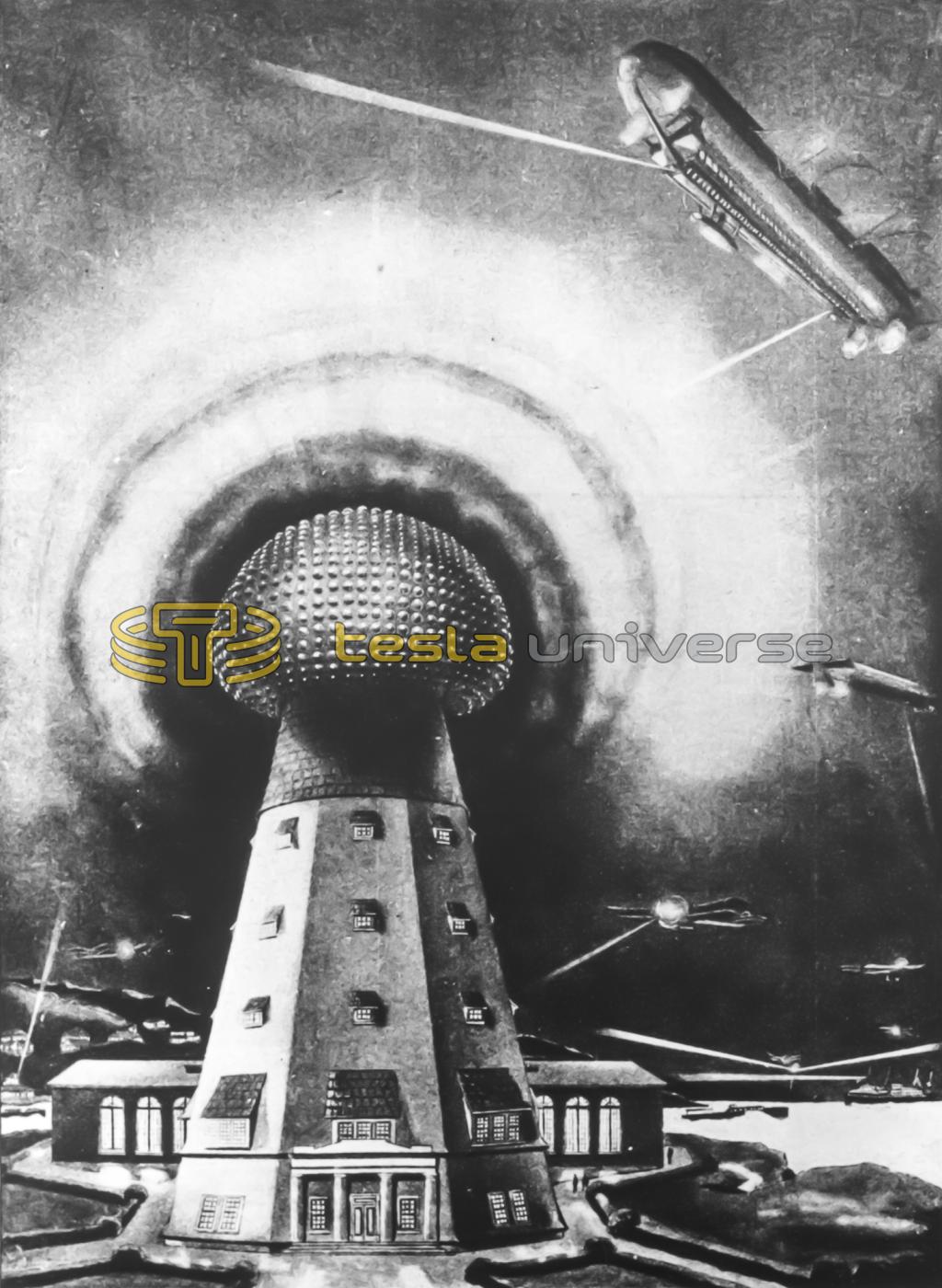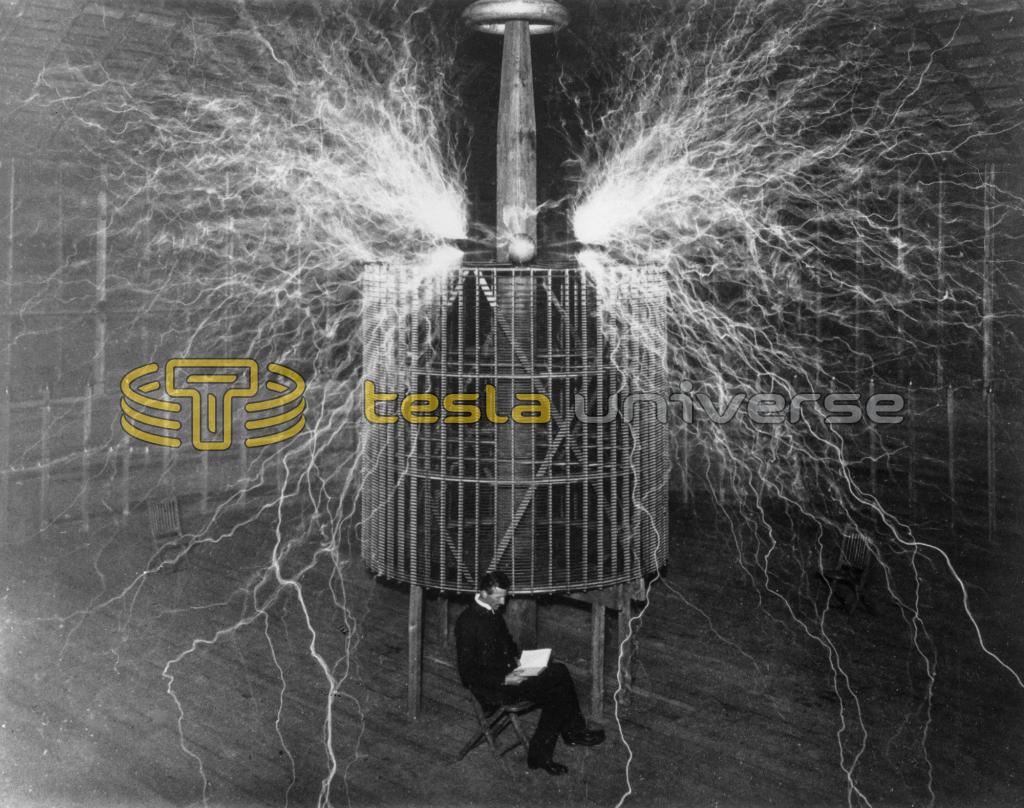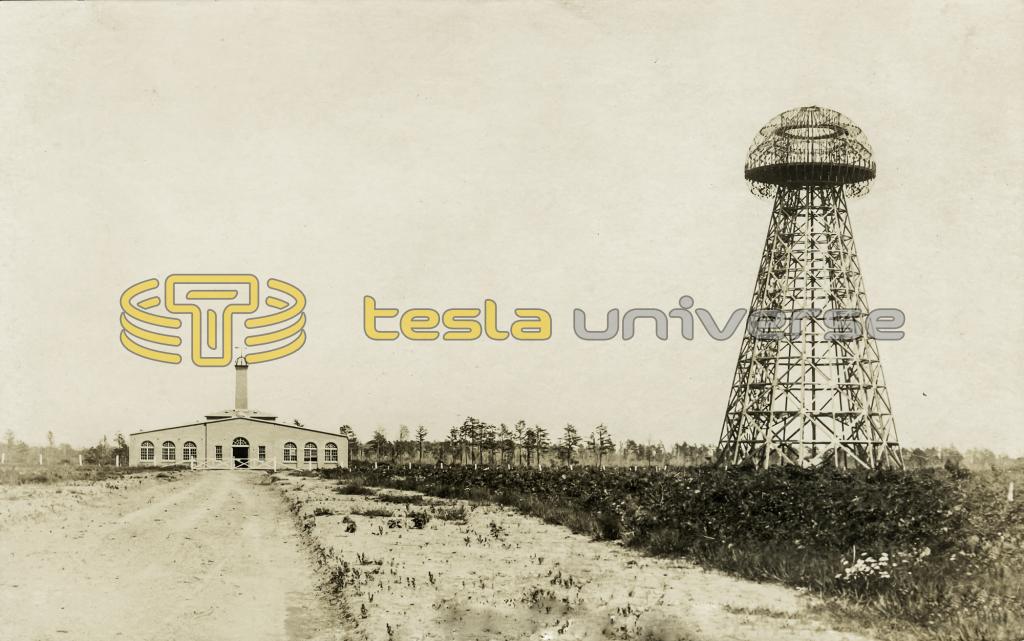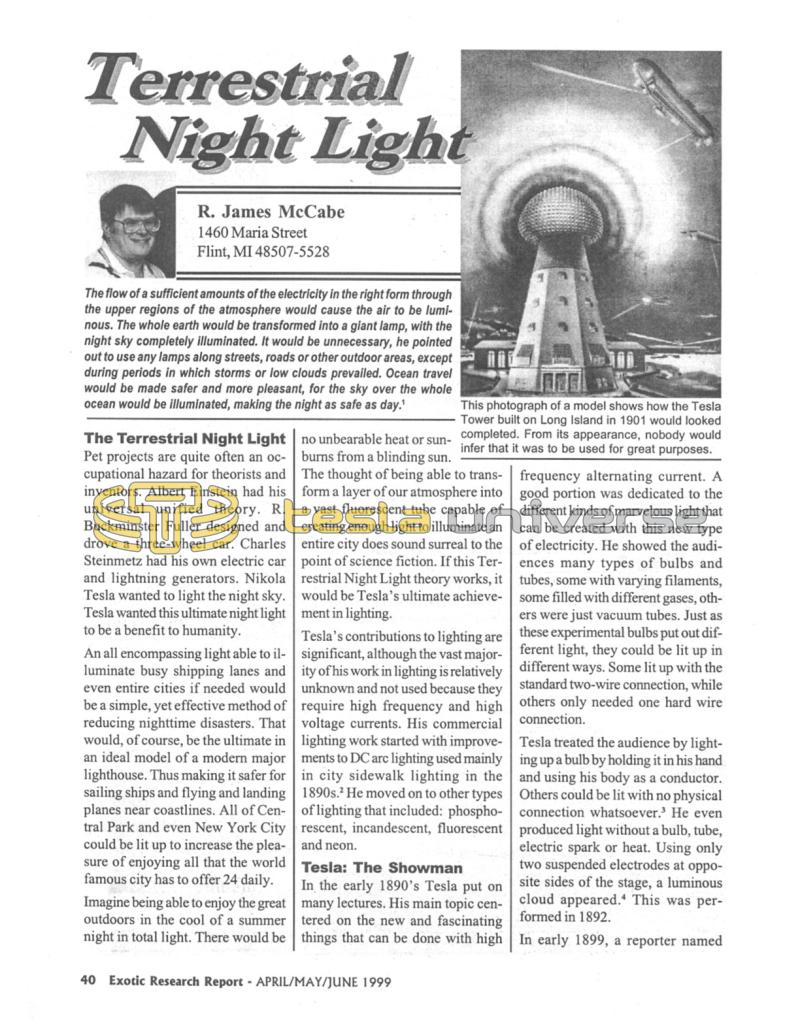
Nikola Tesla Articles
Terrestrial Night Light
The flow of a sufficient amounts of the electricity in the right form through the upper regions of the atmosphere would cause the air to be luminous. The whole earth would be transformed into a giant lamp, with the night sky completely illuminated. It would be unnecessary, he pointed out to use any lamps along streets, roads or other outdoor areas, except during periods in which storms or low clouds prevailed. Ocean travel would be made safer and more pleasant, for the sky over the whole ocean would be illuminated, making the night as safe as day.1
The Terrestrial Night Light
Pet projects are quite often an occupational hazard for theorists and inventors. Albert Einstein had his universal unified theory. R. Buckminster Fuller designed and drove a three-wheel car. Charles Steinmetz had his own electric car and lightning generators. Nikola Tesla wanted to light the night sky. Tesla wanted this ultimate night light to be a benefit to humanity.
An all encompassing light able to illuminate busy shipping lanes and even entire cities if needed would be a simple, yet effective method of reducing nighttime disasters. That would, of course, be the ultimate in an ideal model of a modern major lighthouse. Thus making it safer for sailing ships and flying and landing planes near coastlines. All of Central Park and even New York City could be lit up to increase the pleasure of enjoying all that the world famous city has to offer 24 daily.
Imagine being able to enjoy the great outdoors in the cool of a summer night in total light. There would be no unbearable heat or sunburns from a blinding sun. The thought of being able to transform a layer of our atmosphere into a vast fluorescent tube capable of creating enough light to illuminate an entire city does sound surreal to the point of science fiction. If this Terrestrial Night Light theory works, it would be Tesla's ultimate achievement in lighting.
Tesla's contributions to lighting are significant, although the vast majority of his work in lighting is relatively unknown and not used because they require high frequency and high voltage currents. His commercial lighting work started with improvements to DC arc lighting used mainly in city sidewalk lighting in the 1890s.2 He moved on to other types of lighting that included: phosphorescent, incandescent, fluorescent and neon.
Tesla: The Showman
In the early 1890's Tesla put on many lectures. His main topic centered on the new and fascinating things that can be done with high frequency alternating current. A good portion was dedicated to the different kinds of marvelous light that can be created with this new type of electricity. He showed the audiences many types of bulbs and tubes, some with varying filaments, some filled with different gases, others were just vacuum tubes. Just as these experimental bulbs put out different light, they could be lit up in different ways. Some lit up with the standard two-wire connection, while others only needed one hard wire connection.
Tesla treated the audience by lighting up a bulb by holding it in his hand and using his body as a conductor. Others could be lit with no physical connection whatsoever.3 He even produced light without a bulb, tube, electric spark or heat. Using only two suspended electrodes at opposite sides of the stage, a luminous cloud appeared.4 This was performed in 1892.
In early 1899, a reporter named Chauncey McGovern attended one of Tesla's private showings in his laboratory. He witnessed many interesting displays of electrical mastery; some may have mistaken for prestidigitation. Tesla snapped his fingers and a fireball appeared in his hands. He handled it like it was a 3-inch cotton ball. In another demonstration, Tesla was able to envelop himself in an electrical flame, a sort of high frequency St. Elmo's Fire.5 A truly awesome sight!
In yet another demonstration he turned off all the lights, leaving everyone in total darkness. Tesla lit the entire laboratory with a beautiful but somewhat eerie light. McGovern and the other guests were not able to locate the source of the light. It was an all-enveloping light that was everywhere but had no starting point. To say that McGovern was impressed by these and other demonstrations is an understatement.6
His Terrestrial Night Light appears to only be possible with very high voltage and high frequency currents. One of Tesla's all time favorite inventions was his Magnifying Transmitter. A giant high frequency air core induction coil. Tesla developed his Magnifying Transmitter while he was in Colorado Springs in 1899.
At Colorado Springs he refined his knowledge of generating and manipulating extremely high voltages. The Magnifying Transformer was to play a key part in his wireless transmission theories. It appears that it is also needed to create the necessary voltages for the Terrestrial Night Light to become a reality.7
Wardenclyffe
In July of 1901, Nikola Tesla started construction on his world wireless project in Long Island, New York. It consisted of a power plant/office building and a global transmitting tower.
The "Tesla Central Power Plant", was a 200 by 200-foot brick building. It contained an office, library, a complete machine shop, an instrument room and a display room filled with many of his most prized inventions.9 The most important reason for this building was the electrical equipment. It housed a steam boiler, turbine and a generator along with other sophisticated electrical apparatus to manipulate and regulate electrical current. The current that was to be used by the magnifying transmitter which was to be located in the Transmitting Tower for World Telegraphy.
Tesla expected the output from the transmitting tower was going to be: 10,000 Hp at 100 million volts.9 An elaborate underground network of tunnels and passageways connected these two buildings. This was a highly engineered electrical and mechanical complex.
The wireless plant was never finished, mainly due to financial reasons. Officially his wireless plant was going to be used for communications. Tesla also had other uses in mind for his wireless plant, including transmitting wireless power without the usual electrical lines to homes and businesses. One of the other uses was sending power to planes in the air and ships at sea. The Terrestrial Night Light appears to require similar technology and problems of conducting the power through the atmosphere. One theory is that Tesla planned to conduct the power to planes and ships by employing an ionizing beam as the electrical conduit for the electrical power.10
Did Tesla Ever... Try to Light the Sky?
Yes, I believe he did test his ideas, at least once. By 1903 The Central Power Plant was nearing completion. The Transmitting Tower was still a mere skeleton, nowhere close to being finished. Starting the night of July 15, 1903 and for the next couple of nights, Tesla set up a few additional poles (antennas), and then fired up the generators that brought the wireless plant to life. From the poles and the top dome of the tower bolts of lightning shot out for miles which actually lit up the sky and could be seen for literally hundreds of miles. At times the surrounding area was filled with streaks of lightning shooting into the darkness. The residents of that area were literally treated to an electrical fireworks display.11
Tesla made a profound statement to the Press:
The people about there, had been awake instead of asleep, at times would have seen even stranger things. Some day, but not at this time, I shall make an announcement of something that I never once dreamed of.12
In June of 1935 Tesla did make another statement about tests that he performed in attempting to send electricity up into the sky. I think this is the statement that Tesla promised so many years before...
I will confess that I was disappointed when I first made tests along this line on a large scale. They did not yield practical results. At the time I used about 8,000,000 to 12,000,000 volts of electricity. As a source of ionizing rays I employed a powerful arc reflected up into the sky. At the time I was trying only to connect a high tension current in the upper strata of the air, because my pet scheme for years has been to light the ocean at night.
However, since 190213 I have made many improvements in my method which I know now will assure success. A power plant upon the Azores, for instance, could send a current up into the stratosphere and illuminate the sky sufficiently for pilots to discern objects upon the ocean at a safe distance.14
Wardenclyffe was located at Rocky Point on Long Island, New York on the coast of the Atlantic Ocean. We also know that Tesla believed that our atmosphere, at lower altitudes, is a good electrical insulator; especially for direct and low frequency alternating currents. At the higher altitudes from 25,000 to 35,000 feet with the lower pressures, it can be a good conductor for high frequency currents.15 The obvious question is, "how do you get the electricity that high in the sky?"
A science writer and close friend of Tesla, by the name of John J. O'Neill, did his very best to get that information from Tesla himself, and could not. All he could do was to speculate that Tesla would use something like his molecular bombardment tube to ionize the air allowing the high voltage current to conduct up to the proper altitude.16 Unknown to O'Neill at the time, on the upper platform (inside the dome) of the transmitting tower was a spot designed to receive a bank of very powerful ultraviolet lamps. O'Neill didn't know about the lamps until after the completion of his biography: Prodigal Genius: The Life of Nikola Tesla.17
At the very top of the dome on the tower, was a round opening that was designed to hold a removable disk. That opening was intended to allow a beam to be projected upward.18 The dome at the top of the tower was fairly large. It was approximately 68 feet in diameter and 34 feet tall, more than enough room for additional electrical apparatus. The true usage for the ultraviolet lamps and removable disk are unknown. The removable disk almost certainly had another use, such as an access door to the top of the dome for maintenance and repairs.
On Labor Day 1917 the tower came down.19 Tesla's dream for a universal system of wireless communication and power was shaken, but remained intact. When he had the time, he continued to work on this project. In the late 20's to early 1930's Tesla was close to building another wireless tower.20
He had an agreement for power from Niagara Falls Power Station. Tesla also contacted Alcoa Aluminum to fabricate the top dome. It appeared that Tesla was considering using poured cement for the exterior walls of the tower.21 Tesla was not afraid to keep working on and improving a concept/idea/invention to make it better. So just as the design of the tower and electrical apparatus changed through the years, his ideas towards his Terrestrial Night Light almost certainly changed as well.
With the onset of World War I, if not soon before, much of Tesla's thoughts turned to war or a way of preventing war. One of Tesla's solutions was his ground based Teleforce, better known as the Death Ray.
How close Tesla ever came to a working model, we will probably never know. We do know that sometime in the 1920 to 30's Tesla worked on and experimented with particle beam apparatus.22 In the same time period there is some evidence that Tesla did bounce beams of light off the moon.23
Tesla did say this technology could be used as a conducting medium through air and space with literally no limitations due to distance or amounts of power. Later in life he talked about being able to beam unlimited power to the moon and other planets.
One Possible Method
In the 1930's when Tesla started talking about lighting the night sky, I think he was contemplating using his Teleforce as the conducting force to get the current up into the atmosphere.24 Tesla did not want his Teleforce to be just another weapon of war. He wanted it to be actively used in a beneficial capacity while standing guard at our borders. He talked about it being able to transmit unlimited amounts of power to distant locations. At a moments notice it could change from one of its peacetime uses, to its alternate purpose of being a ground based defensive weapon.
Electrical technology has grown exponentially in the last few decades. Such an elaborate plant as Tesla's Wardenclyffe should not be required with today's technology. Tesla's overall accomplishments in electricity and light should give him enough credibility to be taken seriously in his seemingly outrageous claim of being able to light the sky. The practical and commercial possibilities for illuminating the night sky would seem to have definite limitations. If a portable unit could be developed and shape the skylight fit to an exact form and intensity, as not to bother surroundings on the perimeter, the commercial potential could be almost without limits.
The potential for such a large all enveloping yet gentle light is not limited to recreational uses like golf courses, lakes, ski slopes and other sporting events. I believe this unique light could be used to the benefit of human life from illuminating airports to helping far northern and southern cities that go long periods of time without any sunlight.
It could have been used on large construction projects such as the Hoover, Niagara, Tennessee Valley Authority, and the Grand Cooley Dam projects. Another possible use could be in search and rescue missions. Instead of lighting an entire ocean or sea, large vessels such as aircraft carriers, and oil tankers, could be able to send up a beam of energy to create a oasis of light one to ten miles in diameter around themselves.
The greatest aid I can think of is in the event of natural disasters, earthquakes, floods, tornadoes and hurricanes. What invaluable aid could it be to the National Guard, Red Cross and other rescuers when the power has been disrupted and night is falling?
Currently there are some very talented researchers, experimenters and scientists trying to breathe new life into some of Tesla's ideas. Many of Tesla's idea's are currently unresolved legacies, and his Terrestrial Night Light is a prime example. I think it was one more possible use of his world wireless plant. This is my attempt to piece together the few remaining clues I can find.
I hope these talented researchers would take a close look at this totally different concept in outdoor lighting for two reasons. First, if this technology is developed and used properly I believe it could be a great benefit to humanity. Second, I think it would be pretty cool to someday be able to beat the heat of an Arizona or Florida's summer by teeing off at 2:00am. - RJM
Reference Notes
- O'Neill, John, J. Prodigal Genius The Life of Nikola Tesla. Angriff Press, 1944, p. 144.
- Cheney, Margaret. Tesla: Man Out of Time. Dell Publishing Co., 1983, pp. 35-36.
- Tesla, Nikola. Experiments with Alternate Currents of High Potential and High Frequency. A lecture before The Institute of Electrical Engineers, London, February, 1892.
- Nikola Tesla and His Business, Scientific American Suppl., May 21, 1892, pp. 13659-60. Also in: Cheney, p. 4.
For more information about this effect, see: McCabe, R. James, Cold Fire, Exotic Research Report, Vol2 No 4, Oct/Nov/Dec. 1998. pp. 41, 43. - Unused
- McGovern, Chauncy, Montgomery, The New Wizard of the West, Pearson's Magazine, May, 1899. pp. 470-476. Also in: Cheney, p. 4.
- Seifer, J, Marc. NIKOLA TESLA: PSYCHOHISTORY OF A FORGOTTEN INVENTOR, Doctoral Dissertation of Saybrook Institute, May, 17, 1986, p. 469.
- Cheney, p. 173.
- Tesla, Nikola. Experiments with Alternate Currents of High Potential and High Frequency. New York: McGraw-Hili Publishing Company, 1904, p. 160.
- Tesla, Nikola. World System of Transmission of Energy, Telegraph and Telephone Age, October 16, 1927. p. 460.
- Cheney, p. 165.
- Tesla's Flashes Startling - But He Won't Tell What He is Trying for at Wardenclyffe, New York Sun, July 17, 1903. col. 1. Lights Seen in Tower, New York Tribune, July 19, 1903. P. 2, col. 4. Also in: Cheney, p. 165.
- Author's Opinion: I think the 1935 statement parallels the July 1903 electric-pyrotechnic experiments. It is my opinion that the quoted date of 1902 is in error. It is quite possible that anyone could say 1902 instead of 1903 during an interview, attempting not to disclose any technical information while attempting to explain complicated electrical tests in lay terms that were performed nearly 32 years earlier. II was most probably misstated or misquoted.
- Tesla Predicts Ships Powered by Shore Beam, New York Herald Tribune, June 5, 1935.
- Cheney, p. 92. Also in: O'Neill, p. 144.
- O'Neill, p. 145.
- Cheney, p, 174.
- Cheney, p. 173.
- Cheney, p, 174.
- Sending of Messages to Planets Predicted by Dr. Tesla on Birthday, New York Times, July 11, 1937, p. 13, col. 2. Also: Experiment Seen as Herald of World Wide Radio Power, The Detroit News, Jan 29, 1928. P. 6.
- Seifer, p. 469.
- Seifer, p. 469.
- Seifer, p. 445, 468.
- New York Times, July 11,1937, p. 13, col. 2. Also in: Seifer pp. 468-469.



